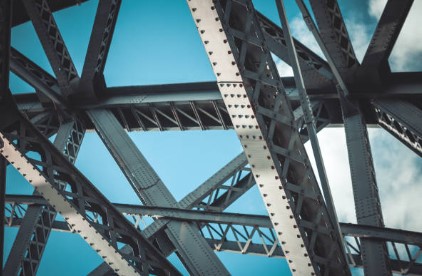Cold Riveting in Construction: Skyscrapers to Steel Bridges.

Every towering skyscraper and sprawling steel bridge we see today is a testament to engineering precision and durability. Behind these marvels of modern construction lies a crucial yet often overlooked fastening technique: cold riveting. Unlike welding or bolted connections, cold riveting provides a unique combination of strength, reliability, and resilience that withstands the test of time. From earthquake-prone regions to coastal cities battered by harsh weather, cold riveting plays a fundamental role in ensuring structural safety.
In the world of construction, where precision and durability are non-negotiable, cold riveting has cemented its place as a go-to fastening method. Its application ranges from securing steel beams in high-rise buildings to reinforcing the decks of expansive bridges. As urban landscapes evolve and the demand for resilient infrastructure grows, understanding the role of cold riveting becomes essential. This article details how cold riveting contributes to construction, from seismic-resistant connections to iconic architectural projects.
Building the Future with Cold Rivets
Cold riveting has revolutionized the construction industry by providing long-lasting and structurally sound connections. Unlike welding, which requires extreme heat, or bolted joints, which can loosen over time, cold riveting creates permanent mechanical bonds that remain intact even under immense pressure and environmental stress. This makes it an ideal choice for projects that demand maximum stability, such as skyscrapers, steel bridges, and large industrial complexes.
One of the standout features of cold riveting is its ability to distribute loads evenly across joints. This reduces stress concentration points, ultimately improving the lifespan of structures. Engineers and construction experts favor cold riveting in projects where vibration, temperature fluctuations, and weather exposure are significant concerns. Using pop rivets and blind rivets in critical applications can help construction teams ensure enhanced safety and durability in modern infrastructure projects.
Seismic-Resistant Structural Connections
In earthquake-prone regions, the integrity of a building’s structural connections is a matter of life and death. Cold riveting provides a highly effective solution for constructing earthquake-resistant frameworks. The ability of riveted joints to withstand dynamic forces makes them a preferred choice in seismic-resistant designs.
Riveted connections allow for slight flexing under seismic stress, preventing sudden fractures that could compromise an entire structure. Unlike welded joints, which can be brittle under shifting loads, cold-riveted assemblies absorb and distribute energy, mitigating damage during an earthquake. As a result, skyscrapers and bridges in high-risk zones incorporate cold riveting as a fundamental part of their safety strategy.
Earthquake Simulation Test Results
Seismic studies have demonstrated that cold-riveted structures outperform their bolted and welded counterparts in earthquake simulations. Some key findings include:
- Enhanced Ductility: Riveted joints retain flexibility, preventing sudden structural failure under seismic stress.
- Load Distribution Efficiency: Forces are spread evenly across rivets, reducing localized damage.
- Resilience Against Fatigue Cracking: Cold-riveted structures exhibit fewer cracks compared to welded components.
- Extended Lifespan: Bridges and skyscrapers built with riveted frameworks maintain their structural integrity over decades of seismic activity.
- Consistent Performance in High-Risk Zones: Real-world observations confirm that riveted buildings withstand earthquakes better than non-riveted constructions.
Retrofitting for Earthquake Protection
To further enhance seismic resistance, older buildings and bridges are being retrofitted with cold-riveted reinforcements. The benefits include:
- Improved Structural Integrity: Strengthening weak points in existing infrastructure.
- Increased Safety Standards: Bringing older buildings up to modern seismic codes.
- Reduced Long-Term Costs: Preventing extensive damage and expensive repairs.
Weatherproofing Solutions
Harsh weather conditions pose a significant challenge for structural longevity. From heavy rains to coastal salt exposure, buildings and bridges must be fortified against the elements. Cold riveting offers a reliable fastening method that ensures structures remain weather-resistant and durable in challenging environments.
Cold riveting prevents water infiltration in joints, reducing the risk of corrosion. This makes it particularly beneficial for infrastructure near oceans, rivers, and other moisture-prone locations. The use of pop rivets and blind rivets in weatherproofing applications enhances the resilience of metal components, ensuring they remain intact and functional for extended periods.
Coastal Infrastructure Protection
Infrastructure in coastal areas faces unique challenges, including saltwater corrosion, high humidity, and strong winds. Cold riveting is instrumental in fortifying these structures by:
- Creating Corrosion-Resistant Joints: Riveted metal components are less prone to rust compared to bolted assemblies.
- Preventing Water Ingress: The tight seal of riveted joints minimizes the risk of internal rusting.
- Enhancing Structural Integrity Against Wind Loads: Riveted frameworks offer superior resistance to hurricane-force winds.
- Reducing Maintenance Costs: Cold-riveted structures require fewer repairs over time.
- Prolonging the Lifespan of Bridges and Buildings: Long-lasting riveted joints ensure the durability of coastal infrastructure.
High-Altitude Weather Challenges
Cold riveting is also used in high-altitude structures facing extreme temperature variations. Benefits include:
- Resistance to Thermal Expansion and Contraction
- Minimized Risk of Frost Damage in Joints
- Long-Term Stability in Harsh Climates
Iconic Project Spotlight
Cold riveting has played a pivotal role in some of the most iconic construction projects worldwide. From historic landmarks to modern engineering feats, its application continues to shape the infrastructure landscape.
Golden Gate Bridge Retrofit Analysis
The Golden Gate Bridge, one of the most famous suspension bridges in the world, underwent an extensive retrofit to enhance its structural resilience. Cold riveting played a crucial role in reinforcing its steel framework, ensuring it remains safe for generations to come. Key benefits of using cold riveting in the retrofit include:
- Improved Load-Bearing Capacity: Riveted joints help distribute the weight of the bridge more efficiently.
- Extended Durability: Cold riveting enhances the longevity of the bridge’s steel framework.
- Resistance to Wind and Traffic Loads: The use of pop rivets and blind rivets reinforces stability against heavy traffic and strong winds.
- Minimized Structural Fatigue: Cold-riveted components experience less wear and tear compared to bolted assemblies.
- Preserved Aesthetic and Historical Integrity: The retrofitting process maintained the original design of the bridge while enhancing its safety features.
Other Notable Cold-Riveted Structures
- Eiffel Tower Structural Reinforcement
- Empire State Building Load-Bearing Enhancements
- Steel Bridges in Seismic Zones
Advancements in Cold Riveting Technology
With technological advancements, cold riveting has become even more efficient and adaptable to modern construction needs. Innovations in rivet materials, installation techniques, and automated riveting processes have further solidified its place in the industry.
Automation in Riveting
Modern construction projects utilize robotic riveting systems to streamline assembly processes. These automated systems improve efficiency and precision, ensuring consistent and reliable connections in large-scale structures.
High-Strength Rivet Materials
Advances in metallurgy have led to the development of high-strength rivets that offer superior performance under extreme conditions. These materials include:
- Stainless Steel Rivets: Ideal for corrosion resistance.
- Aluminum Rivets: Lightweight yet durable for aerospace and construction applications.
- Titanium Rivets: Exceptional strength for high-load structural components.
- Composite Rivets: Designed for compatibility with modern materials.
- Hybrid Rivets: Combining multiple metals for optimized performance.
Conclusion
Cold riveting remains an indispensable technique in the construction industry, ensuring the safety, durability, and longevity of structures ranging from skyscrapers to steel bridges. Its ability to withstand seismic activity, resist harsh weather conditions, and provide secure, maintenance-free connections makes it a preferred fastening method for engineers worldwide.
As cities continue to expand and infrastructure demands grow, cold riveting will play an even greater role in shaping the future of construction. With advancements in technology and material science, its applications will continue to evolve, reinforcing the structures that define our modern world. Whether in earthquake-prone zones or coastal environments, cold riveting stands as a symbol of strength, reliability, and engineering excellence.




